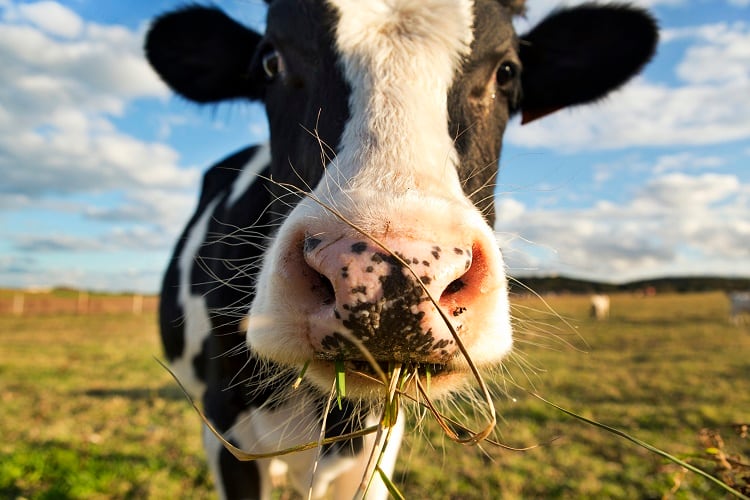Antibiotics are given to livestock in varying degrees around the world, largely in order to treat and prevent disease. While in the UK and EU, antibiotic use is more stringently regulated than in the US, this does not mean antibiotics are never given to European livestock.
In the dairy sector, antibiotic use must be regulated in order to prevent the milk from being affected by antimicrobial residues. If residues make their way into the milk, this could put consumers at risk and potentially cause antimicrobial resistance (AMR), which is when bacteria become resistant to antibiotics.
Antibiotics in European dairy
In order to ensure that milk does not contain antibacterial residues, farmers must implement a withdrawal period between giving a dairy cow antibiotics, and letting their milk get into the supply chain.
“Antibiotics can potentially get into milk consumed by the public if dairy animals are treated with antibiotics and withdrawal periods are not respected,” Ernesto Liebana, leader of the Biological Hazards team at European Food Standards Agency (EFSA), told FoodNavigator.
“Consuming milk with antibiotics can contribute to exposure of humans to antimicrobial residues and therefore to antimicrobial resistance. For this reason, it is important for farmers to use antibiotics according to marketing authorisations.”
Combatting antimicrobial resistance using cultivated meat
Because the process is far more controllable and pathogens easier to get rid of, it’s possible to significantly lower (or completely eliminate) antibiotic use in the production of cultivated meat compared with traditional meat.
According to a recent EFSA report, released in February last year, 0.17% of the milk samples analysed were non-compliant with regulations regarding antimicrobial residues in milk in the EU. This was lower than the previous 12 years.
"For antimicrobials, the process to establish levels of residues that can be tolerated, maximum residue levels (MRLs), considers the risk of residues of antimicrobials generating AMR or making bacteria resistant to antimicrobials, and the MRLs are considered safe also from a selection of resistance point of view," added a spokesperson for the European Medicines Agency (EMA).
"It is important for dairy farmers to follow proper protocols when treating animals with antibiotics, including observing withdrawal periods to ensure that milk from treated animals does not enter the food supply until the antibiotics have cleared their systems. Additionally, regulatory agencies and food safety authorities play a crucial role in monitoring and enforcing standards to prevent antibiotic residues in milk and other food products." The EU has several regulations in place on the MRLs for various different antibiotics.
The EU regulates the use of antimicrobials in livestock, restricting their use as a control treatment to prevent the spread of infection, as well as banning their use in groups of animals, via medicated feed, and to promote growth and higher yield. It also ensures that EU member states collect data on antimicrobial use.
Antibiotics for livestock cannot be completely done away with, Liebana told us. However, their use can be mitigated and there are other ways to ensure that farm animals are safe from infections.
“An increased focus on preventive measures such as better nutrition, vaccination, and biosecurity protocols to keep animals healthy can lead to a reduction in the need to use antimicrobials in farming,” said Liebana.
“In order to reduce the need for antimicrobial use, there is a need to re-think the livestock system by implementing farming practices that prevent the introduction and spread of the disease into farms and by considering alternative farming systems which are viable with reduced use of antimicrobials. Education and awareness of antimicrobial resistance should be addressed to all levels of society and in particular to veterinarians and farmers.”
According to the EMA, sales of intramammary products, which are used almost exclusively in dairy, represented 0.74% of European sales of veterinary antimicrobials in 2022. The organisation doesn't have data on other antibiotics.
Antibiotics in UK dairy
Much like in European dairy, antibiotic use in UK dairy is stringently regulated. “Antibiotics are used in UK dairy cows only once they have been prescribed by a vet to tackle a particular health problem in an individual animal or sometimes in a herd of cows,” Catherine McLaughlin, chair of the Responsible use of Medicines in Agriculture (RUMA) Alliance, an organisation that promotes good medicine use in the UK livestock industry, told FoodNavigator.
“The vet follows a procedure to ensure the right antibiotics are prescribed under the general principle of ensuring the right medicine is used at the right time and in the right way. Most fresh milk sold in the UK is produced on farm assured farms which also has stipulations on how antibiotics can be used, but the health of the animal is at the heart of all of these elements of medicine use.”
Consumers concerned about antibiotic use
According to two studies published last year, one of consumers’ main concerns when buying pork is that it is antibiotic use, alongside things such as animal welfare, climate impact and whether animals are fed soy. On one of the studies, the desire for the product to be ‘antibiotic-free’ even came above animal welfare.
According to the UK’s Veterinary Medicines Directorate, many types of antibiotics used in dairy are decreasing. For example, between 2021 and 2022, sales of lactating cow products went down by 6%, sales of dry cow intramamery products decreased by 18%, and sales of HP-CIA Intramammary products lowered by 13% (the data from said report represents 28% of adult dairy cattle).
The amount of time after a UK dairy cow is given an antibiotic that their milk can enter the food supply chain is strictly regulated. “Any prescription of antibiotics also includes instructions on withdrawal periods. This means that when a cow is treated with antibiotics, her milk does not enter the food chain for a specific period of time set out on the medicines approval licence. This is a fail-safe mechanism to protect consumers from any risks of antibiotic residues entering the food chain,” RUMA’s McLaughlin told us.
“UK livestock sectors have made huge progress in tackling AMR and reducing use over the last decade, taking ownership and defining reduction targets – a journey that has been robustly monitored and reported on and which evidences significant reductions.”





